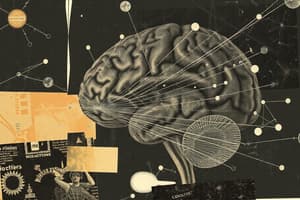Podcast
Questions and Answers
What percentage of retinal ganglion cell axons cross hemispheres at the optic chiasm?
What percentage of retinal ganglion cell axons cross hemispheres at the optic chiasm?
- Approximately 40%
- Approximately 20%
- Approximately 60% (correct)
- Approximately 80%
Which structure is responsible for the reflex control of pupil and lens?
Which structure is responsible for the reflex control of pupil and lens?
- Lateral geniculate nucleus
- Superior colliculus
- Pretectum (correct)
- Hypothalamus
A patient has lost the ability to coordinate head and eye movements in response to visual targets. Which area is most likely damaged?
A patient has lost the ability to coordinate head and eye movements in response to visual targets. Which area is most likely damaged?
- Lateral geniculate nucleus
- Superior colliculus (correct)
- Striate cortex
- Hypothalamus
Which nerve transmits signals from the Edinger-Westphal nucleus to the ciliary ganglion?
Which nerve transmits signals from the Edinger-Westphal nucleus to the ciliary ganglion?
What is the function of the constrictor muscles of the iris?
What is the function of the constrictor muscles of the iris?
A patient exhibits a normal pupillary light reflex in both eyes when light is shone in either eye. What does this suggest?
A patient exhibits a normal pupillary light reflex in both eyes when light is shone in either eye. What does this suggest?
Which type of eye movement is characterized by having both a fast (saccade) and slow (smooth pursuit) component?
Which type of eye movement is characterized by having both a fast (saccade) and slow (smooth pursuit) component?
Which condition results from blocking direction selectivity in the retina?
Which condition results from blocking direction selectivity in the retina?
The primary visual cortex (V1) receives direct projections from which structure?
The primary visual cortex (V1) receives direct projections from which structure?
What type of visual information projects to the left brain hemisphere?
What type of visual information projects to the left brain hemisphere?
How are images entering the eye affected by the eye's optics?
How are images entering the eye affected by the eye's optics?
What is unique about vision in the periphery of the visual field?
What is unique about vision in the periphery of the visual field?
How do fibers representing the superior and inferior visual fields travel from the LGN to V1?
How do fibers representing the superior and inferior visual fields travel from the LGN to V1?
Magnocellular layers of the LGN receive input from ganglion cells with what characteristics?
Magnocellular layers of the LGN receive input from ganglion cells with what characteristics?
The parvocellular layers of the LGN are specialized for processing what type of information?
The parvocellular layers of the LGN are specialized for processing what type of information?
The koniocellular layers' role is unknown, but what layers do they interdigitate?
The koniocellular layers' role is unknown, but what layers do they interdigitate?
What is the organization of the primary visual system (retina, LGN, V1)?
What is the organization of the primary visual system (retina, LGN, V1)?
Following damage to the optic tract on the right side, what visual field deficit would most likely occur?
Following damage to the optic tract on the right side, what visual field deficit would most likely occur?
What did Hubel And Wiesel discover about the receptive fields in V1?
What did Hubel And Wiesel discover about the receptive fields in V1?
What is the term for cells in V1 that only respond to bars of light moving across the receptive field in one direction?
What is the term for cells in V1 that only respond to bars of light moving across the receptive field in one direction?
In the hierarchical organization of the visual system, what type of receptive field would you expect to find in a simple cell in the primary visual cortex?
In the hierarchical organization of the visual system, what type of receptive field would you expect to find in a simple cell in the primary visual cortex?
What type of stimulus best activates a simple cell in V1?
What type of stimulus best activates a simple cell in V1?
What are the layers of the primary visual cortex?
What are the layers of the primary visual cortex?
Where do superficially located pyramidal cells project to?
Where do superficially located pyramidal cells project to?
Cells immediately above and below one another in the cortex have the same location in the visual field. What is this referred to as?
Cells immediately above and below one another in the cortex have the same location in the visual field. What is this referred to as?
What are orientation pinwheels?
What are orientation pinwheels?
What is a hypercolumn?
What is a hypercolumn?
What is stereopsis?
What is stereopsis?
What is the cause of strabismus?
What is the cause of strabismus?
In the visual system, what deficit does long-term, untreated strabismus in childhood cause?
In the visual system, what deficit does long-term, untreated strabismus in childhood cause?
What describes the other visual brain areas downstream from V1?
What describes the other visual brain areas downstream from V1?
Which visual area contains neurons that selectively respond to motion in specific directions, but doesn't care about color?
Which visual area contains neurons that selectively respond to motion in specific directions, but doesn't care about color?
What is the purpose of higher brain regions?
What is the purpose of higher brain regions?
What area processes motion in the visual system?
What area processes motion in the visual system?
What can cause the aperture problem?
What can cause the aperture problem?
Neurons in what area integrate input from neurons with smaller receptive fields, so they can detect the overall direction of movement of an object?
Neurons in what area integrate input from neurons with smaller receptive fields, so they can detect the overall direction of movement of an object?
The ventral stream is more concerned with what the semantic nature of the is?
The ventral stream is more concerned with what the semantic nature of the is?
What stream is particularly concerned with moving objects?
What stream is particularly concerned with moving objects?
If the optic tract on the left side is damaged, affecting visual information processing, what would be the most likely consequence?
If the optic tract on the left side is damaged, affecting visual information processing, what would be the most likely consequence?
What best describes the progression of visual information in the primary visual pathway?
What best describes the progression of visual information in the primary visual pathway?
What is the functional organization of the primary visual cortex?
What is the functional organization of the primary visual cortex?
After processing in V1, visual information diverges into the dorsal and ventral streams. What are the main characteristics and functions of these streams?
After processing in V1, visual information diverges into the dorsal and ventral streams. What are the main characteristics and functions of these streams?
In the visual system, what problem does area MT solve from the signals it receives from V1?
In the visual system, what problem does area MT solve from the signals it receives from V1?
Flashcards
Retinal Ganglion Cell Axons
Retinal Ganglion Cell Axons
Axons of retinal ganglion cells that leave the eye and project to different brain areas.
Optic Chiasm
Optic Chiasm
Area where some optic nerve fibers cross to the opposite side of the brain.
Lateral Geniculate Nucleus (LGN)
Lateral Geniculate Nucleus (LGN)
Relay center in the thalamus for the visual pathway.
Conscious Vision Pathway
Conscious Vision Pathway
Signup and view all the flashcards
Subconscious Vision
Subconscious Vision
Signup and view all the flashcards
Hypothalamus (Suprachiasmatic Nucleus)
Hypothalamus (Suprachiasmatic Nucleus)
Signup and view all the flashcards
Melanopsin
Melanopsin
Signup and view all the flashcards
Superior Colliculus
Superior Colliculus
Signup and view all the flashcards
Pretectum
Pretectum
Signup and view all the flashcards
Edinger-Westphal Nucleus (EWN)
Edinger-Westphal Nucleus (EWN)
Signup and view all the flashcards
Oculomotor Nerve
Oculomotor Nerve
Signup and view all the flashcards
Ciliary Ganglion
Ciliary Ganglion
Signup and view all the flashcards
Saccadic Eye Movements
Saccadic Eye Movements
Signup and view all the flashcards
Smooth Pursuit Eye Movements
Smooth Pursuit Eye Movements
Signup and view all the flashcards
Optokinetic Reflex
Optokinetic Reflex
Signup and view all the flashcards
Nucleus of the Optic Tract
Nucleus of the Optic Tract
Signup and view all the flashcards
Primary Visual Pathway
Primary Visual Pathway
Signup and view all the flashcards
Segregation of Visual Information
Segregation of Visual Information
Signup and view all the flashcards
Monocular Visual Field
Monocular Visual Field
Signup and view all the flashcards
Flipped retinal images
Flipped retinal images
Signup and view all the flashcards
LGN to V1 projections
LGN to V1 projections
Signup and view all the flashcards
Magnocellular Layers
Magnocellular Layers
Signup and view all the flashcards
Parvocellular Layers
Parvocellular Layers
Signup and view all the flashcards
Koniocellular Layers
Koniocellular Layers
Signup and view all the flashcards
Retinotopic Map
Retinotopic Map
Signup and view all the flashcards
Foveal Over-representation
Foveal Over-representation
Signup and view all the flashcards
Visual Field Deficits
Visual Field Deficits
Signup and view all the flashcards
Orientation selective cells
Orientation selective cells
Signup and view all the flashcards
Direction Selective Cells
Direction Selective Cells
Signup and view all the flashcards
Spatial/Temporal Frequency
Spatial/Temporal Frequency
Signup and view all the flashcards
Center Surround
Center Surround
Signup and view all the flashcards
Orientation Selective
Orientation Selective
Signup and view all the flashcards
Cortical Layers
Cortical Layers
Signup and view all the flashcards
Orientation Column
Orientation Column
Signup and view all the flashcards
Orientation Pinwheel
Orientation Pinwheel
Signup and view all the flashcards
Binocular Vision
Binocular Vision
Signup and view all the flashcards
Hypercolumn
Hypercolumn
Signup and view all the flashcards
Stereopsis
Stereopsis
Signup and view all the flashcards
Strabismus
Strabismus
Signup and view all the flashcards
Downstream from V1
Downstream from V1
Signup and view all the flashcards
Midde Temporal Area (MT)
Midde Temporal Area (MT)
Signup and view all the flashcards
Area V4
Area V4
Signup and view all the flashcards
Dedicated Vision
Dedicated Vision
Signup and view all the flashcards
‘what pathway’
‘what pathway’
Signup and view all the flashcards
‘where’ pathway
‘where’ pathway
Signup and view all the flashcards
Study Notes
- The visual system comprises visual reflexes and higher visual pathways.
Central Projections of Retinal Ganglion Cells
- Retinal ganglion cell axons exit the eye via the optic nerve.
- These axons project to many brain regions.
- Axons reach the optic chiasm, where roughly 60% cross hemispheres contralaterally.
- The remaining axons stay on the ipsilateral side.
Different Visual Pathways
- Conscious vision goes through the lateral geniculate nucleus of the thalamus to the primary visual cortex (V1).
- Subconscious vision uses other retinal pathways.
- These pathways drive reflexes, circadian rhythms, and subconscious visual perception.
- The hypothalamus's suprachiasmatic nucleus is essential for photo-entrainment of the circadian rhythm.
- Retinal ganglion cells that drive circadian rhythms express melanopsin and are intrinsically photosensitive.
- The superior colliculus coordinates head and eye movements to visual targets.
Pupillary Light Reflex
- Certain retinal ganglion cells send axons to the pretectum.
- Pretectal neurons project to the Edinger-Westphal nucleus (EWN) in the midbrain.
- EWN neurons send axons through the oculomotor nerve to the ciliary ganglion.
- Ciliary ganglion cell neurons innervate constrictor muscles of the iris reducing pupil diameter.
- Both pupils respond to monocular visual stimulation.
Optokinetic Reflex
- The optokinetic reflex, or optokinetic nystagmus, is a gaze stabilizing reflex.
- Consists of a fast (saccade) and slow (smooth pursuit) component.
- A subset of directionally selective retinal ganglion cells project to the Nucleus of the Optic Tract.
- This leads to activation of cranial nerves controlling eye muscles.
- Blocking direction selectivity in the retina ablates the optokinetic reflex.
- Even a simple reflex results in wide-scale brain activity.
Primary Visual Pathway
- The primary visual pathway underlies conscious vision.
- Retinal ganglion cells project to the lateral geniculate nucleus of the thalamus (LGN).
- LGN relay neurons then project to the primary visual cortex.
Segregation of Visual Information
- Information from the right visual field projects to the left brain hemisphere.
- Information from the left visual field projects to the right brain hemisphere.
- Temporal-retina-originating signals from each eye join with nasal-retina-originating signals from the other eye at the optic chiasm.
Eye's View of the World
- Each eye has its own visual field.
- Combined, they create a binocular visual field.
- Vision in the periphery of the visual field is monocular.
- Due to lens optics, images entering the eye are flipped vertically and horizontally.
Projections from LGN to V1
- Fibers representing superior vs. inferior visual fields take different paths from LGN to V1.
Parallel Visual Pathways from Retina to V1
- The two ventral LGN layers are magnocellular.
- Magnocellular layers receive input from ganglion cells with larger receptive fields and more transient, motion-sensitive responses.
- Dorsal LGN layers are parvocellular.
- Parvocellular layers receive inputs from retinal ganglion cells with small receptive fields and more sustained responses, also signaling color information.
- Koniocellular layers interdigitate between parvo and magno cellular layers, but the role is unclear.
- Magnocellular cells from the LGN project to layer 4Ca in V1, thought to originate from parasol ganglion cells.
- Parvocellular cells from the LGN project to layer 4Cẞ in V1, thought to originate from midget ganglion cells.
- Koniocellular cells from the LGN project to patches in layer 2/3 of V1, thought to originate from non-midget, non-parasol ganglion cells.
Retinotopic Map
- In the primary visual system, neighboring parts of the visual field are processed by neighboring parts of the brain.
- The foveal region has greater representation in the visual cortex.
Impact of Damage on Visual Pathway
- Damage along the primary visual pathway can lead to differential visual field deficits.
Receptive Field Properties in Visual Cortex
- David Hubel and Torsten Wiesel found small circular spots robustly drove responses in retinal ganglion and LGN relay neurons, but did not strongly drive cells in V1.
- V1 prefer elongated edges oriented at a specific angle (orientation selective cells) to be stimulated.
- When the bar moved orientation cells only responded.
- Cells respond when the bar was moved across the receptive field in one of the angles perpendicular to the long-axis of the bar (i.e. direction selective cells).
- Cells care about spatial frequency and temporal frequency of visual stimuli.
Hierarchical Organization of Visual System
- Center Surround exist in LGN neuron.
Architecture of Primary Visual Cortex
- The cortex is a highly layered neuronal structure.
- It consists of 6 layers which can be grouped or subdivided.
- LGN axons mostly innervate neurons in layer 4C.
- Superficially located pyramidal cells project to other cortical areas.
- Deeper cortical pyramidal cells project to subcortical targets like the LGN and superior colliculus.
Functional Organization of Primary Visual Cortex
- Cells immediately above and below represent the same location and exhibit similar feature selective responses = orientation column.
- Less overlapping receptive fields and different feature selective responses exist beside each other.
Orientation Pinwheels
- Color-coded surface view of the primary visual cortex based on preferred cell orientation.
- Cells with similar orientations cluster together.
- Given a field location, all orientations are present (orientation pinwheel).
- At the next receptive field location, all orientations are again present, which repeats every ~1mm.
Binocular Vision
- Contralateral and ipsilateral retinal axons project to separate layers in the LGN.
- The eye-specific segregation is passed onto the input layer (layer 4) of primary visual cortex, causing ocular dominance.
- Most neurons are binocular, but receive stronger input from one eye.
Hypercolumn
- All the different spatially segregated functional modules overlay in V1.
Stereopsis
- Stereopsis arises from viewing nearby objects with two eyes in slightly different locations.
- Objects in front of or behind the plane of fixation project project to non-corresponding parts.
- Disparity between eyes generates depth perception.
- Visual cortex contains far, near, and tuned zero cells that respond to different disparities.
Strabismus and Amblyopia
- Strabismus, when eyes do not align properly, can be esotropia (cross-eyed) or exotropia (eyes deviate outwards).
- Untreated strabismus in childhood can lead to amblyopia, where the brain stops processing inputs from one eye.
Higher Visual Areas
- There are visual brain areas with complete maps of visual space downstream from V1.
- Higher brain regions are dedicated to specific visual detection tasks.
- The middle temporal area (MT) contains neurons that selectively respond to motion, and V4 contains many color selective cells.
Dorsal and Ventral Streams
- The ventral stream is concerned with object recognition.
- The dorsal stream is concerned with moving objects.
Area MT
- Area MT in the dorsal stream detects motion.
Aperture Problem
- V1's receptive fields are small which can mislead the recognition of movement.
Neurons in Area MT
- Neurons integrate input from neurons with smaller perceptive fields.
- They can detect the overall direction of movement of objects.
Ventral Streams
- The ventral stream is in charge of perception of colour, and object recognition.
Face Cells
- Face cells are regarded as high-odrer, visual object selective cells.
Studying That Suits You
Use AI to generate personalized quizzes and flashcards to suit your learning preferences.




